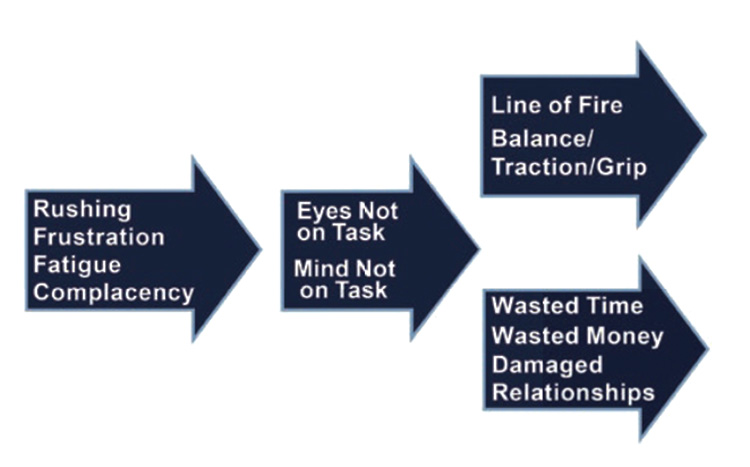Integrating Human Factors Into Operational Performance A Conversation Between Larry Wilson And Alex Carnevale – President, Dynacast International
-By Mackenzie Wilson
It has become widely accepted that human factors have a big impact on safety. States like rushing, frustration, fatigue and complacency can lead us to make critical errors that increase the risk of us getting hurt. But is an injury or a close call the only potential outcome of this state to error pattern? Or is it likely that the things that cause us to make the mistakes that get us hurt, are the same things that cause us to make mistakes, period? Larry Wilson (author of SafeStart and host of Larry Wilson Live) invited Alex Carnevale (President – Dynacast International and former Chief Performance Officer at Etex) onto the podcast to discuss the crossover between safety and operational performance. Specifically, they discussed the silo effect, and why it can be so difficult to get lessons learned from safety into other areas of the organization – like production, quality and customer service. More importantly, they described ways to leverage the takeaways from safety into other departments to achieve greater operational performance.
Larry begins the podcast by explaining that the first conversation he and Alex had upon meeting – surprisingly enough – was about basketball. “When you’re talking about sports you’d never separate human error from human performance,” Larry says, “in tennis, they even track the number of unforced errors. But when you think about making steel, gasoline, or cars, there is a tendency to think about system performance instead of human performance.” Through this initial conversation, the two realized they shared a mutual appreciation for the influence of human factors on performance – whether it be personal or operational. “What I realized was that the behavioral aspect of safety is the only thing that matters in the moment,” says Alex, “whether you should or shouldn’t be in the situation you are in doesn’t matter – in that moment.” He goes on to explain, “of course you need to work on improving equipment, guarding and obviously you need to make your procedures as sound as possible – but in the moment it’s all about the decisions and errors you can make that determine or influence what happens in the next moment. And in that moment, when a quality error, production mistake or critical error that could cause an injury could happen, the only thing you have is the human element.”
Larry agrees. But it’s also obvious that he never really saw it from that perspective: meaning that regardless of right or wrong, good or bad or as stated before, whether you should or shouldn’t be in the situation that you’re in now, none of that matters – in that moment. Alex continues, “we can fix or improve whatever needs to happen to that situation – later, but that’s later. It’s not now.”
Larry then briefly explains the state to error pattern that causes over 95% of all errors for the audience who may not be familiar with it (Alex already is). He covers how rushing, frustration, fatigue and complacency–or more likely a combination of those four states or human factors–can lead to errors like eyes not on task and mind not on task. Often, one or both of those two errors can cause injuries if people move into the line-of-fire or lose their balance, traction or grip. However, those same errors can cause production errors, quality mistakes or problems with customer relations. He then goes on to explain that “It’s just 4 different risk triangles: one for safety, one for quality, one for production and one for customer relations.” Alex nods in agreement, “It seems very direct or very obvious to me,” Alex says, “that the same things that would impact safety from a human error or behavioral standpoint would affect every other area of the business. After all, it’s not like anybody is ever trying to make a mistake.”
“And there is data to support this,” Larry explains, “multinational companies in many industries have shown significant improvements in the reduction of scrap, first-run defects, unscheduled downtime and customer complaints – as well as injuries when trained in human factors and critical error reduction techniques.” But (somewhat unfortunately), however straightforward this connection may seem, the spillover or transfer from safety into other departments is hardly automatic. Alex explains that there are a few factors that inhibit the spillover. “Firstly, training in human factors and critical error reduction techniques, which involves learning new skills like self-triggering, changing habits, making observations and analyzing close calls, doesn’t give instant gratification.” “The nature of the beast,” Alex explains, “is that the benefits or improvements from this training are (usually) only observable over time and with a large set of data or a large group of people. But a lot of the time in production and operations, you want to see an almost immediate change or measurable return on investment… to put it simply, there’s a leap of faith when you try to improve the human element vs. bringing in a new piece of equipment that you know will produce more.” The other reason for the lack of spillover that Alex brings up is that for some leaders there is still a stigma surrounding human error. “We didn’t do this perfectly at Etex,” admits Alex, “but one of the elements of doing safety training aimed at behavior or reducing human error, is that you want to make sure it’s not about blame – you want to recognize the error or deficiency, yes – but we all make mistakes. ”He makes a good point. We all make mistakes. And lots and lots of them. “But,” as Alex continues, “depending on the outcome of the mistake, we treat it differently.”

Larry agrees emphatically and explains this by giving the comparison between two common mistakes involving eyes and mind not on task. “If a fork truck driver backed the truck off of a loading dock and got hurt, there would typically be all sorts of root-cause analysis to try to make sure that it doesn’t happen again. However, if the same employee made an error like sending a truckload of product to the wrong customer, there might not be a root cause analysis. Typically, that employee’s ‘rap sheet’ would be called into question. In other words, their supervisor or boss would look at how many mistakes (priors, to continue the analogy) they’ve made like this in the past to determine if or how severely they will be reprimanded. It wouldn’t likely be the same blame-free analysis that it would have been had the employee’s mistake resulted in an injury. “There’s a couple levels when we’re talking about mistakes not being corrected,” says Alex, “but I think the secret or the key to productivity, quality or safety are the little mistakes that happen all the time,” which for most people is something like 50-100 per day: whether it be a wrong keystroke, a typo, dropping something, miss-scheduling or entering the wrong data, these things add up to a significant total. “It’s hard to track in terms of each individual instance, but when taken together it really does matter in terms of total efficiency.” Larry agrees. “Because we make so many little mistakes every day we don’t really notice them, unless the consequences are severe. For example, say you drop your phone. The chances are that you really wouldn’t pay that much attention to it unless it broke or the screen cracked. But you could learn just as much from it not breaking.” Which is what happens with safety. Near-misses are reported and analyzed to prevent a similar error from happening again. So how come we don’t do this in other areas?
One factor, explains Alex, is organizational bandwidth, or simply how much an organization is able to pay attention to and dive into an event at any given time. The ‘silo effect’ is another factor, and with it the notion that the things a company does for safety are different from the things it should do for quality, or production, or customer relations. Larry gives a great example of the silo effect with a story from a few years ago. He explains that in health care, human error is obviously a big risk in terms of patient safety (in North America medical error is the third leading cause of death). So, this area is monitored by a risk-management division. There’s also another division that looks after staff safety and ergonomics. “The gentleman who was in charge of staff safety for a large number of hospitals in California wanted me to talk to his leadership group, and I said ‘Can you get the people from risk management to come out as well?’ to which the gentleman replied, ‘That would be a great idea, but I don’t know any of them.’” It seems almost ironic that both divisions are working on the same problem – human error and behavior – and yet they think they are trying to solve different problems. Alex explains that this is actually a perfect example to demonstrate the synergies between safety and process. “Let’s take an ER doctor for example,” he says, “this is a critical decision making role that has a fundamental human element. You want that human to be as sharp as possible.” He explains that to help that human, there are many things that can be done on the process side, like having a good data system, patient history, inventory on open beds in the hospital, scheduling, etc. “But what all of that is doing, is simply helping the human element.”

Whether it be operational bandwidth or the silo effect, Alex believes that there is a common path to follow in terms of what leadership needs to do. He explains that at his former workplace, consistent leadership principles were responsible for much of their success. “We didn’t tell leaders that if ‘x’ happens then they should do ‘y’, instead we got everybody aligned on what the principles are, how we want to work, what we value in terms of agility, feedback and transparency. That way”, he continues, “then whenever any situation arises, they know how to deal with it – which includes getting to the root causes, sharing the information, and being clear about the final solution. “It’s a VUCA world we live in these days,” says Alex, meaning volatile, uncertain, complex and ambiguous. “Things change, things move fast, what that says is that the human element and the ability to take in different pieces of information and process it into action becomes even more critical.” In summary, what really makes any initiative successful–whether it be in safety or performance–is having a coherency and consistent plan that people understand. “The difference between companies that have successful implementations in all areas (vs. just safety) and those that don’t, is the company’s people and the ability to make it stick. Which all starts with leadership buy in. You have to be a zealot, a bit crazy,” says Alex, “people need to feel the same passion you bring to safety when you’re bringing it to other areas of the organization.”
The two conclude by discussing the benefit of integrating human factors into safety first, and then into the other areas of the organization. “There’s a certain appeal for safety because it’s a core value for everybody, so why not lead with that and then transfer the skills over to other areas” says Larry, “the other plus is if you do the safety part first, there’s a natural tendency to take the concepts home to the family.” By doing this, employees get to practice the concepts 24/7. Alex agrees. “The places we had the most success were those where they took it outside of the factory and home to their families,” However, he does suggest providing a few examples and having discussions at the beginning of the training on how the concepts and techniques can apply to all aspects of the business – including finance, administration, marketing and sales will help to get more initial leadership support.
It’s difficult to dispute the value of integrating human factors into all areas of the organization. But it can’t be done without concerted effort and buy in from leadership. “It takes passion, commitment, and honest communication to make any initiative stick. And the company needs to do its part to reduce the rushing, frustration, fatigue and complacency wherever and whenever it can”. Alex then goes on to explain why he went back from 12-hour shifts to 8-hour shifts: “It wasn’t just the number of injuries in those last four hours. You could also see the decline in production and quality. But I knew this wasn’t going to make me popular. They liked the 12-hour shifts and the long weekends. One of the easiest ways to get everyone to accept this change was with the injuries or through a common value like safety. However, once everyone began seeing the positive effect that reducing fatigue had on safety, it was much easier to begin integrating the concepts into other areas like production, quality and customer relations”. And he concludes by saying, “Because, at the end of the day, the state-to-error pattern that’s involved in over 95% of our injuries is exactly the same as the one that causes over 95% of our mistakes and errors. The challenge is getting the employees and the leadership group to see the connection, and then getting both groups to do their part: leadership trying to reduce those human factors wherever they can, and the employees practicing and using the critical error reduction techniques whenever they find themselves rushing, frustrated, fatigued or complacent.
For more information
www.asia.safestart.com



